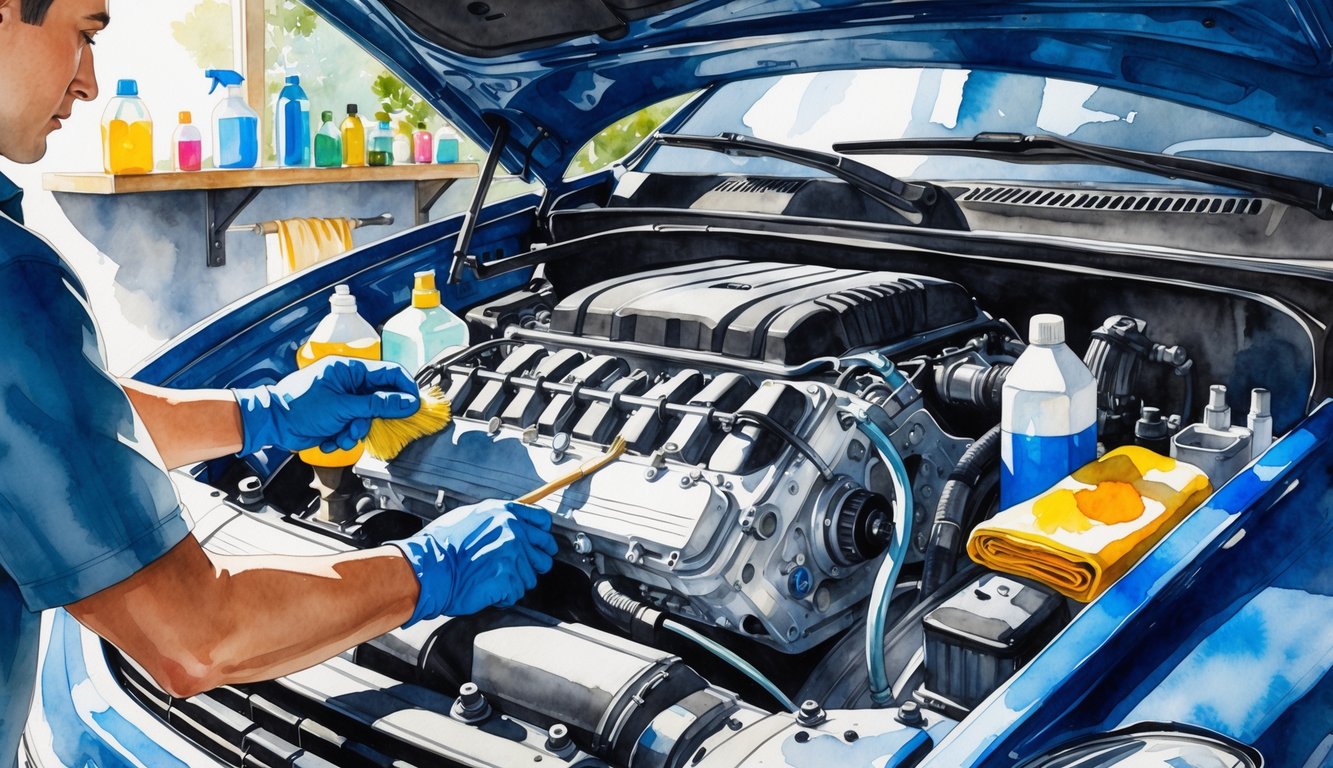
Common Mistakes to Avoid for a Safe Engine Bay Detail
So, mid-degreasing—flashback to last summer’s disaster—I keep watching people dump water everywhere like it’s a car wash. They ignore the world’s easiest tip: Cover your battery! Cover the alternator with a plastic bag, or don’t, and listen to sudden electrical shorts. I’ve seen more fried coil packs than I can count. ASE-certified techs grumble about this constantly.
Using harsh household cleaners? Yeah, I get the urge—“it’s just dirt”—but no. Simple Green Pro HD (the purple one) doesn’t etch metals or melt plastics, but some sprays from the grocery store will absolutely destroy anodized brackets and brittle clips. Meguiar’s D108 is supposedly safer, but I still nearly grab glass cleaner by accident. Lazy habits, ruined sensors.
High-pressure water at connectors? I wish I was making this up, but I’ve seen someone blast a wiring harness so hard the MAP sensor popped out. Toyota’s shop next door says an Altima limps in every week with “mystery” errors—usually after Uncle Ken’s “detail job.” Moisture gets trapped, ECU freaks out, you’re out a few hundred bucks.
Toyota’s 2023 Service Manual says even a quick hand-mist with distilled water should be immediately followed by compressed air. Nobody ever has an air gun, so water just sits under ignition modules.
Let’s not even start on metal brushes near plastic coolant lines. Unless you’ve got a $70,000 Snap-On scanner to clear codes, just don’t. And jewelry—never wear jewelry. I welded my own wedding band to a fuse box once. How is that not in every YouTube tutorial?
Frequently Asked Questions
You’d think everyone remembers the plastic bag trick, but I keep popping hoods and finding soggy sensors and little grime pools behind the battery. The whole “spray vs. wipe” debate never dies—probably because half the guides online skip a step you can’t undo.
What steps are essential for protecting components during engine bay cleaning?
Watched my neighbor clean his Civic—just drenched the fuse box. Distilled water or not, it finds every crack you missed. Taping connectors isn’t enough; Honda literally says in their workshop manual (section 9-38, for the nerds) to shield the alternator and main harness with zip bags.
My old Forester’s throttle body survived my lazy towel barrier, even with degreaser, but my buddy’s BMW fried the idle circuit after one careless rinse. That stubborn hose by the windshield that always drips? Stuff a rag under it or you’ll regret it next week.
Can you recommend the best products to use for engine bay detailing?
There’s always someone hyping “all-natural,” but honestly, Chemical Guys’ Silk Shine or Griot’s Garage Engine Cleaner do the job when elbow grease just smears the mess. Someone used baby wipes once—oil never came off for three weeks.
Dealership techs I trust won’t touch unknown foam stuff; Adam’s Polishes Engine Bay Cleaner tested clean on sensors, no residue, while Meguiar’s Ultimate Black streaked my hands and, somehow, the steering wheel. Still no clue how that happened.
Should I opt for professional engine cleaning or can I DIY safely?
My cousin nuked a coil pack with “gentle” pressure washing—YouTube said it was fine (he skipped the manual, page 221, figures). Some shops, like DetailM8 in Seattle, offer insurance for accidental damage, but the quotes? Might as well rebuild the engine.
DIY could save money, but unless you’re reading factory torque specs and wiring diagrams, something’s probably going to short. And nobody charges you for the stress of wondering if you’ve fried a sensor until the check engine light pops up a week later.
How can I effectively clean my engine bay without causing water damage?
Water damage hides for days—my ex-roommate’s Corolla ran fine until three days after he soaked the O2 sensor harness. I skip full-force hoses and use a hand sprayer—more hassle, but Toyota’s TSB EG045-17 is weirdly clear: only damp rags near ignition coils.
Drying takes forever unless you’ve got a leaf blower, and running the engine for five minutes never dries connectors under the fuse box. Why does nobody mention that? Seems off, right?
What’s the difference between engine bay dressing and detailing?
Parts store guy swore engine bay dressing is “detailing.” Nope. Dressings like Stoner’s More Shine look slick for a day, but I’ve seen sticky buildup clog sensor housings (Honda bulletin 06-048 warns about it).
Detailing, at least to me, means scrubbing, targeted decontamination, pH safe stuff (5-8, per Autogeek), and absolutely no silicone left on wire looms. What is it with people loving shiny plastic like it’s proof they maintain their car?
Are there any common mistakes to avoid when detailing an engine bay at home?
Honestly, people just skip torqueing fasteners. Like, all the time. I saw this NAPA survey from 2023—62% of folks flat-out admitted they never bother checking the plastic cover bolts after putting them back on. Sixty-two percent! Is that laziness, or am I missing something? Anyway, I always forget to vacuum first, too, and then, surprise, I’m flicking little rocks straight into the intake plenum. Amazing.
And, oh, the things I’ve seen. Watched a guy—no joke—just spray WD-40 all over his pulleys because, I guess, “lubrication’s good”? His serpentine belt squeaked like a haunted hamster wheel for months. WD-40, by the way, is basically dust bait and does nothing for insulation. Why is that never in the instructions? Also, can someone explain why manuals just ignore battery terminal corrosion after you clean everything up? Just once, I’d like a warning. Or maybe I missed it.
